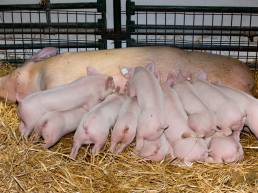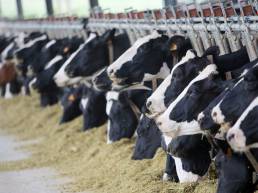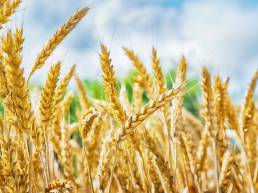This newsletter is intended to inform you about mycotoxins and the serious effects they can have on animals.
Nowadays, adequately controlling the growth of bacteria and fungi is possible, but mycotoxins still pose a risk due to their impact on animal health. In practice, mycotoxins still often seem to be forgotten. However, the media is giving increasing attention to the impact and risks of mycotoxins. A recent example is the tool launched by All about feed, which displays the regulations regarding mycotoxin contamination for various products per country.
The 2016 growing season in Western/Central Europe has been very wet and changeable, but without extremely high temperatures. Many farmers have experienced damage, total crop failure or lower yields. High humidity and low temperatures create an ideal climate in the soil for the development and explosive growth of fungi. These fungi develop further on the crops. The variable weather during this growing season causes stress in fungi, which leads to the increased formation and excretion of mycotoxins. Mycotoxins are difficult to monitor because they are odourless and colourless. Mycotoxins are also almost impossible to remove from crops due to their high chemical stability and insensitivity to temperature. For this reason, mycotoxins remain present during harvest and storage.
In addition to being affected by field fungi, stored grain can be attacked by fungi that flourish in storage and produce mycotoxins. This formation of fungi and therefore mycotoxins is countered with fungicides. Field fungi, however, are almost unstoppable. An example of a field fungus is ergot Claviceps purpurea, which grows on the ears of grain (see image 1).
Grains and other crops are never completely free of mycotoxins. The levels of mycotoxins in European crops will be high in the 2016 harvest due to the weather conditions. Mycotoxins are toxic to animals, however, as with all substances, the dose determines the toxicity.
For various reasons, it is difficult to determine the level of mycotoxins in grains and feed and therefore their toxicity and the consequences. One of the reasons is that mycotoxins can occur in the form of hotspots, which makes it easy to miss them during sampling. This means that batches with high mycotoxin contents can slip through the net and end up in the silo. Secondly, the production of mycotoxins depends on the conditions experienced by the fungi. Finally, mycotoxins can strengthen each other synergistically. This synergistic effect, along with other factors in the stall (e.g., infection and management), means that the symptoms can vary greatly between animals and stalls.
Mycotoxins
In total, more than 450 different mycotoxins are known. The six most commonest mycotoxins in grains and feeds are aflatoxin (AFLA), zearalenone (ZEA), deoxynivalenol (DON), T-2 toxin (T-2), fumonisin (FUM) and ochratoxin A (OTA).
Each separate mycotoxin causes specific symptoms in animals. Also the sensitivity of animals to the different toxins varies. For example, DON can cause leg problems and growth variations in the stall, and can also suppress the immune system. High levels of DON can cause decreased feed intake or even complete refusal of feed. ZEA affects the endocrine system and therefore the reproductive cycle and fetus. Some effects in practice include a lower birth rate, young animals with birth defects, or prolapsed uteri. In male, ZEA can affect the sperm quality.
The adverse effects of mycotoxins becomes often visible within weeks or months after feeding animals with contaminated feed. E.F.S. therefore advises the regular analysis of raw materials and feed for the presence of mycotoxins. The effects of mycotoxins in animals can be countered with products that bind and deactivate mycotoxins. It is wise to already start using these products preventively in feed wherein grain from the new harvest will be used. Tox-Aid® is an effective tool for this, and using this product can significantly reduce the damage caused by mycotoxins.
Tox-Aid®
Tox-Aid® is a combination of the right type of bentonite, inactivated yeast and herbal extracts and is a natural remedy that limits the damage caused by mycotoxins. Bentonite is capable of binding certain mycotoxins, while the inactivated yeasts- in addition to this property – can also deactivate mycotoxins by using enzymes. This converts the structure of the mycotoxins into a harmless form which is subsequently excreted. The added herbal extract supports the liver and reduces the oxidative stress in the animal.
Dosage
The recommended dosage of Tox-Aid® is dependent upon the type and level of mycotoxins in a feed. The standard dosages are listed in the table.
| Contamination level | Dosage |
| High | 2.5 kg |
| Low | 1.0-1.5 kg |
| Preventive | 0.5-1.0 kg |
Table 1. Tox-Aid® dosage in kg per ton of feed
E.F.S. possesses an extensive database of information regarding mycotoxins. If you would like to receive more specific information about mycotoxins or the product Tox-Aid®, please contact the E.F.S. team.
You may also like
Tox-Aid® organic authorisation
June 29, 2020
Tox-Aid® is on the organic input list! Tox-Aid® has been authorised for use in organic feeds to limit the negative effects of mycotoxins in the animal. This product has a three-stage effect, i.e. deactivation by means…
Tox-Aid®: Masked Mycotoxins
January 28, 2017
E.F.S. believes that nature has a solution for everything. Mycotoxins are part of a natural process and it appears that masked mycotoxins are present in crops, feed materials and feed. Maybe you have already heard the…
Tox-Aid®: Mycotoxins in dairy farming
July 23, 2016
Mycotoxins are an underestimated problem in livestock. More knowledge has been gained in the past few decades about fungi, mycotoxins and their effects. Therefore fungi are more and more recognised as a problem at…
E.F.S. launches Tox-Aid®
October 1, 2013
Although mycotoxins are relevant throughout the year, this is definitely the time to pay extra attention to this subject. New harvests are just around the corner. As of today, E.F.S. is bringing its own product against…
Should we worry about mycotoxins in dairy feed?
May 23, 2011
Cows are capable of detoxifying limited amounts of mycotoxins in the rumen. This is on condition that the cow's rumen works properly. However, some mycotoxins have a very negative impact on the rumen flora which…








